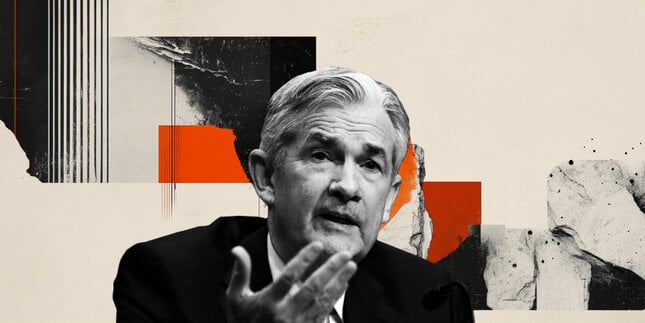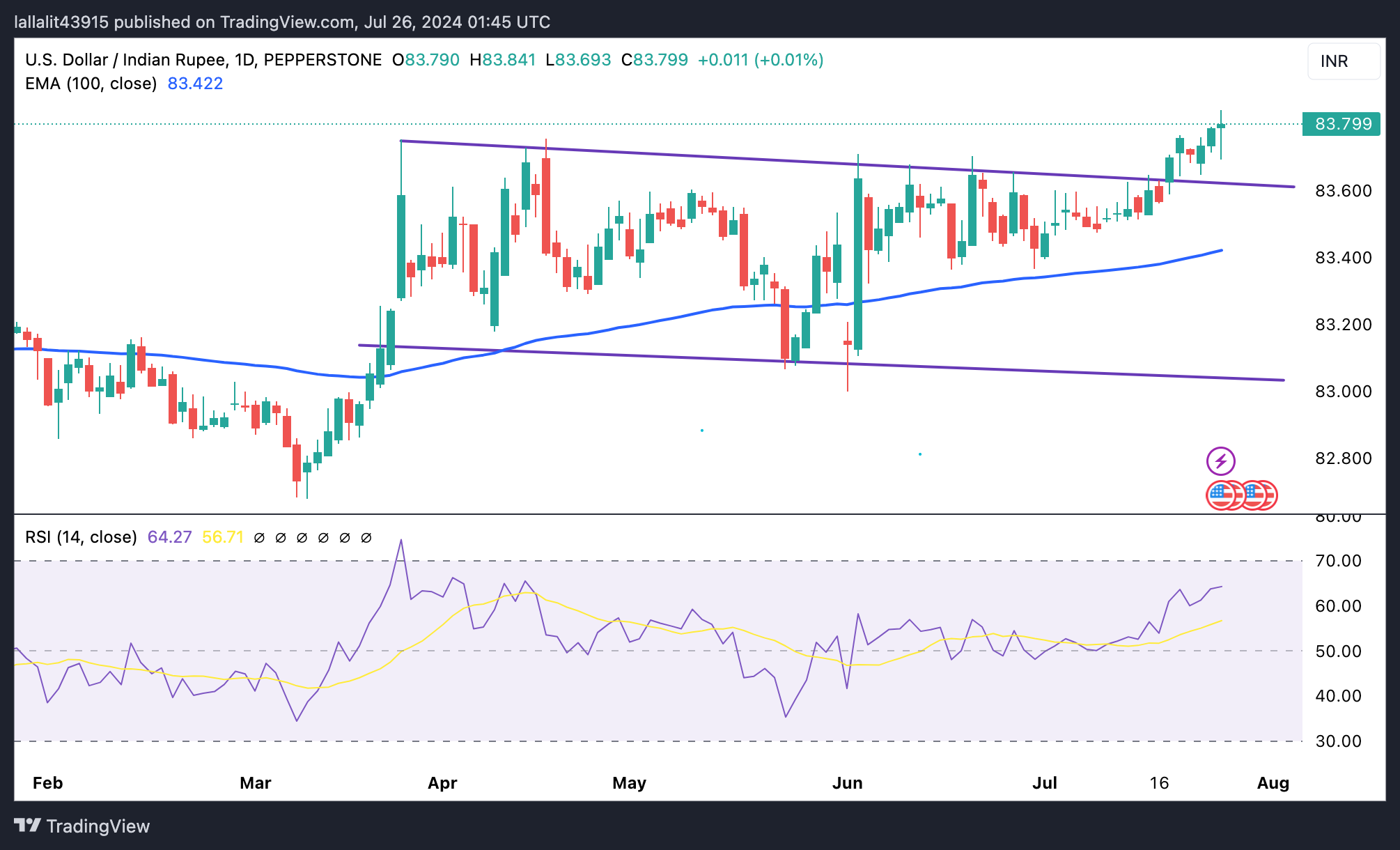- The Indian Rupee recovers some lost ground in Friday’s Asian session.
- The renewed US Dollar demand and foreign outflows from India might undermine the INR.
- US PCE data for June will be in the spotlight on Friday.
The Indian Rupee (INR) posts modest gains on Friday on the weaker Greenback. The month-end US Dollar (USD) demand and India’s foreign outflows drag the INR lower to an all-time low on Thursday. Forex traders said foreign fund outflows from Indian equities following the government’s decision to raise capital gains tax from equity investments and equity derivative trades might weigh on the local currency in the near term.
However, the potential intervention from the Reserve Bank of India (RBI) might cap the INR’s downside, with support from record-high foreign exchange reserves. Investors will closely monitor the US Personal Consumption Expenditures (PCE) Price Index data for June on Friday. The headline PCE is expected to show an increase of 0.1% MoM in June, while the Fed’s preferred measure of inflation, the Core PCE, is expected to ease to 2.5% YoY in June from 2.6%. The softer PCE inflation data could pave the way for the Fed to lower its key interest rate as soon as September and might weaken the USD.
Daily Digest Market Movers: Indian Rupee rebounds, but the potential upside seems limited
- Indian government could impose caps on local bonds if inflows surge, said India's Economic Affairs Secretary Ajay Seth. He added that the government has scope to conduct more bond buybacks depending on market conditions.
- "But that doesn't mean every future security has to be fully accessible. Incrementally, changes can be made to keep a check on foreign fund inflows," he said.Importers have been aggressively purchasing the US Dollar to benefit from a relatively lower rate of crude oil prices in recent weeks, according to forex traders.
- US Gross Domestic Product (GDP) grew at a 2.8% annualized pace adjusted for seasonality and inflation from 1.4% in the previous reading, exceeding forecasts of 2%.
- US Initial Jobless Claims for the week ending July 20 increased by 235K, compared to the previous week of 245K, less than the expected 238K.
- US Durable Goods Orders dropped by 6.6% MoM in June from a 0.1% increase in May, below the consensus of 0.3%. Meanwhile, Core Durable Goods ex Transportation rose by 0.5% MoM in June, up from a 0.1% decline and better than a projection of 0.2%.
- Traders have priced in 92.8% odds that the Fed will maintain its benchmark interest rate between 5.25% and 5.50% at its upcoming July meeting next week, according to the CME FedWatch Tool.
Technical analysis: Indian Rupee remains weak in the longer term
The Indian Rupee trades with mild gains on the day. The USD/INR pair maintains the uptrend, characterized by an uptrend line while holding above the key 100-day Exponential Moving Average (EMA) on the daily timeframe. Furthermore, the 14-day Relative Strength Index (RSI) holds above the midline near 62.45, indicating bullish momentum.
The immediate resistance level for the pair will emerge at the all-time high of 83.85. Extended gains above this level could take USD/INR to the 84.00 psychological mark.
On the other hand, any follow-through selling below 83.65, a low of July 23, might drag the pair lower to 83.51, a low of July 12. The potential support level is seen at 83.42, the 100-day EMA.
Indian Rupee FAQs
The Indian Rupee (INR) is one of the most sensitive currencies to external factors. The price of Crude Oil (the country is highly dependent on imported Oil), the value of the US Dollar – most trade is conducted in USD – and the level of foreign investment, are all influential. Direct intervention by the Reserve Bank of India (RBI) in FX markets to keep the exchange rate stable, as well as the level of interest rates set by the RBI, are further major influencing factors on the Rupee.
The Reserve Bank of India (RBI) actively intervenes in forex markets to maintain a stable exchange rate, to help facilitate trade. In addition, the RBI tries to maintain the inflation rate at its 4% target by adjusting interest rates. Higher interest rates usually strengthen the Rupee. This is due to the role of the ‘carry trade’ in which investors borrow in countries with lower interest rates so as to place their money in countries’ offering relatively higher interest rates and profit from the difference.
Macroeconomic factors that influence the value of the Rupee include inflation, interest rates, the economic growth rate (GDP), the balance of trade, and inflows from foreign investment. A higher growth rate can lead to more overseas investment, pushing up demand for the Rupee. A less negative balance of trade will eventually lead to a stronger Rupee. Higher interest rates, especially real rates (interest rates less inflation) are also positive for the Rupee. A risk-on environment can lead to greater inflows of Foreign Direct and Indirect Investment (FDI and FII), which also benefit the Rupee.
Higher inflation, particularly, if it is comparatively higher than India’s peers, is generally negative for the currency as it reflects devaluation through oversupply. Inflation also increases the cost of exports, leading to more Rupees being sold to purchase foreign imports, which is Rupee-negative. At the same time, higher inflation usually leads to the Reserve Bank of India (RBI) raising interest rates and this can be positive for the Rupee, due to increased demand from international investors. The opposite effect is true of lower inflation.
Information on these pages contains forward-looking statements that involve risks and uncertainties. Markets and instruments profiled on this page are for informational purposes only and should not in any way come across as a recommendation to buy or sell in these assets. You should do your own thorough research before making any investment decisions. FXStreet does not in any way guarantee that this information is free from mistakes, errors, or material misstatements. It also does not guarantee that this information is of a timely nature. Investing in Open Markets involves a great deal of risk, including the loss of all or a portion of your investment, as well as emotional distress. All risks, losses and costs associated with investing, including total loss of principal, are your responsibility. The views and opinions expressed in this article are those of the authors and do not necessarily reflect the official policy or position of FXStreet nor its advertisers. The author will not be held responsible for information that is found at the end of links posted on this page.
If not otherwise explicitly mentioned in the body of the article, at the time of writing, the author has no position in any stock mentioned in this article and no business relationship with any company mentioned. The author has not received compensation for writing this article, other than from FXStreet.
FXStreet and the author do not provide personalized recommendations. The author makes no representations as to the accuracy, completeness, or suitability of this information. FXStreet and the author will not be liable for any errors, omissions or any losses, injuries or damages arising from this information and its display or use. Errors and omissions excepted.
The author and FXStreet are not registered investment advisors and nothing in this article is intended to be investment advice.
Recommended content
Editors’ Picks

AUD/USD weighed down by China, tariffs
AUD/USD remained on the back foot, slipping back to the area of multi-year lows around 0.5950 on the back of mounting fears surrounding tariffs and their impact on the Chinese economy.

EUR/USD refocuses on 1.1000 amid tariffs jitters
EUR/USD reversed two daily pullbacks in a row an d managed to advance to the boundaries of the 1.1000 barrier on the back of fresh weakness hurting the US Dollar and persistent tariff fears.

Gold erases gains, back to the $2,980 zone
Gold prices now lose extra ground and slip back to the area of daily troughs near $2,980 mark per troy ounce following an unsuccesful attempt to maintain the trade above the critical $3,000 level earlier in the day.

XRP drops 3% as Ripple announces $1.25 billion acquisition of prime brokerage firm Hidden Road
Ripple announced on Tuesday that it is acquiring prime brokerage firm Hidden Road to enhance its institutional offerings and increase the adoption of the RLUSD stablecoin and the XRP Ledger (XRPL).

The Fed is looking at a hefty price level
We are still in thrall to tariffs, the faux-macro “data” driving markets. The WSJ editorial board advised other countries to take their tariffs to zero so that Trump’s “reciprocal” tariffs will have to be zero, too. Cute, but no cigar.

The Best brokers to trade EUR/USD
SPONSORED Discover the top brokers for trading EUR/USD in 2025. Our list features brokers with competitive spreads, fast execution, and powerful platforms. Whether you're a beginner or an expert, find the right partner to navigate the dynamic Forex market.




